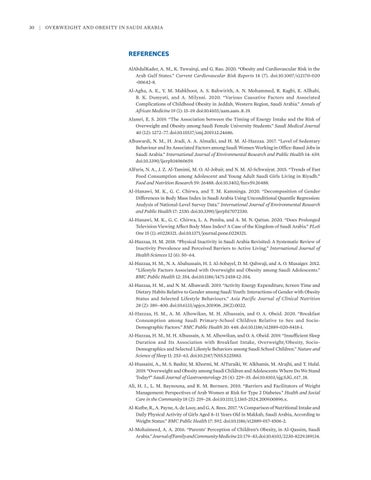30
|
Overweight and Obesity in Saudi Arabia
REFERENCES AlAbdulKader, A. M., K. Tuwairqi, and G. Rao. 2020. “Obesity and Cardiovascular Risk in the Arab Gulf States.” Current Cardiovascular Risk Reports 14 (7). doi:10.1007/s12170-020 -00642-8. Al-Agha, A. E., Y. M. Mabkhoot, A. S. Bahwirith, A. N. Mohammed, R. Ragbi, E. Allhabi, B. K. Dumyati, and A. Milyani. 2020. “Various Causative Factors and Associated Complications of Childhood Obesity in Jeddah, Western Region, Saudi Arabia.” Annals of African Medicine 19 (1): 15–19. doi:10.4103/aam.aam_8_19. Alamri, E. S. 2019. “The Association between the Timing of Energy Intake and the Risk of Overweight and Obesity among Saudi Female University Students.” Saudi Medical Journal 40 (12): 1272–77. doi:10.15537/smj.2019.12.24686. Albawardi, N. M., H. Jradi, A. A. Almalki, and H. M. Al-Hazzaa. 2017. “Level of Sedentary Behaviour and Its Associated Factors among Saudi Women Working in Office-Based Jobs in Saudi Arabia.” International Journal of Environmental Research and Public Health 14: 659. doi:10.3390/ijerph14060659. AlFaris, N. A., J. Z. Al-Tamimi, M. O. Al-Jobair, and N. M. Al-Schwaiyat. 2015. “Trends of Fast Food Consumption among Adolescent and Young Adult Saudi Girls Living in Riyadh.” Food and Nutrition Research 59: 26488. doi:10.3402/fnr.v59.26488. Al-Hanawi, M. K., G. C. Chirwa, and T. M. Kamninga. 2020. “Decomposition of Gender Differences in Body Mass Index in Saudi Arabia Using Unconditional Quantile Regression: Analysis of National-Level Survey Data.” International Journal of Environmental Research and Public Health 17: 2330. doi:10.3390/ijerph17072330. Al-Hanawi, M. K., G. C. Chirwa, L. A. Pemba, and A. M. N. Qattan. 2020. “Does Prolonged Television Viewing Affect Body Mass Index? A Case of the Kingdom of Saudi Arabia.” PLoS One 15 (1): e0228321. doi:10.1371/journal.pone.0228321. Al-Hazzaa, H. M. 2018. “Physical Inactivity in Saudi Arabia Revisited: A Systematic Review of Inactivity Prevalence and Perceived Barriers to Active Living.” International Journal of Health Sciences 12 (6): 50–64. Al-Hazzaa, H. M., N. A. Abahussain, H. I. Al-Sobayel, D. M. Qahwaji, and A. O. Musaiger. 2012. “Lifestyle Factors Associated with Overweight and Obesity among Saudi Adolescents.” BMC Public Health 12: 354. doi:10.1186/1471-2458-12-354. Al-Hazzaa, H. M., and N. M. Albawardi. 2019. “Activity Energy Expenditure, Screen Time and Dietary Habits Relative to Gender among Saudi Youth: Interactions of Gender with Obesity Status and Selected Lifestyle Behaviours.” Asia Pacific Journal of Clinical Nutrition 28 (2): 389–400. doi:10.6133/apjcn.201906_28(2).0022. Al-Hazzaa, H. M., A. M. Alhowikan, M. H. Alhussain, and O. A. Obeid. 2020. “Breakfast Consumption among Saudi Primary-School Children Relative to Sex and SocioDemographic Factors.” BMC Public Health 20: 448. doi:10.1186/s12889-020-8418-1. Al-Hazzaa, H. M., M. H. Alhussain, A. M. Alhowikan, and O. A. Obeid. 2019. “Insufficient Sleep Duration and Its Association with Breakfast Intake, Overweight/Obesity, SocioDemographics and Selected Lifestyle Behaviors among Saudi School Children.” Nature and Science of Sleep 11: 253–63. doi:10.2147/NSS.S225883. Al-Hussaini, A., M. S. Bashir, M. Khormi, M. AlTuraiki, W. Alkhamis, M. Alrajhi, and T. Halal. 2019. “Overweight and Obesity among Saudi Children and Adolescents: Where Do We Stand Today?” Saudi Journal of Gastroenterology 25 (4): 229–35. doi:10.4103/sjg.SJG_617_18. Ali, H. I., L. M. Baynouna, and R. M. Bernsen. 2010. “Barriers and Facilitators of Weight Management: Perspectives of Arab Women at Risk for Type 2 Diabetes.” Health and Social Care in the Community 18 (2): 219–28. doi:10.1111/j.1365-2524.2009.00896.x. Al-Kutbe, R., A. Payne, A. de Looy, and G. A. Rees. 2017. “A Comparison of Nutritional Intake and Daily Physical Activity of Girls Aged 8–11 Years Old in Makkah, Saudi Arabia, According to Weight Status.” BMC Public Health 17: 592. doi:10.1186/s12889-017-4506-2. Al‑Mohaimeed, A. A. 2016. “Parents’ Perception of Children’s Obesity, in Al‑Qassim, Saudi Arabia.” Journal of Family and Community Medicine 23: 179–83. doi:10.4103/2230‑8229.189134.






